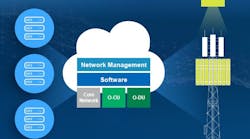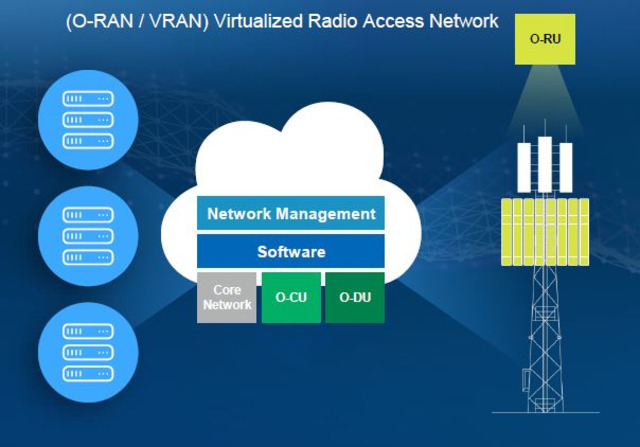Reprinted with permission from Evaluation Engineering
There has been a lot of attention being paid to the roll-out of 5G-based systems and the underlying infrastructures, and Analog Devices is one of the companies aggressively addressing the core technology and devices required. For example, the company has announced a series of collaborative efforts to support 5G networks with companies including NEC, Intel, and Marvell. In the case of NEC and Analog Devices, the two teamed up to design a 5G Network Massive MIMO Antenna Radio Unit for Rakuten Mobile, adopting ADI’s fourth-generation wideband RF transceiver solution.
The cloud-native virtual network heralds a major shift in how communications providers can offer high-speed internet access worldwide, at significantly lower costs, made possible without the maintenance, upkeep, repair and labor costs associated with the physical infrastructure that hinders conventional networks. We wanted to get a little more insight into these developments, So we reached out to Joe Barry, VP of Wireless Communications at ADI, to talk about the company's efforts in 5G development.
Then all of the aspects around telemetry, monitoring telemetries, etc. All of that's reality now. That's where the industry is. I see this very much so in the communication infrastructure business, because part of the challenge here is you have to look at all of the equipment OEMs and the complexity of the products that are required now in 5G operation inside of the network. And the number of product skews that they have to manage. It's becoming increasingly challenging. You have to do things differently.
Everyone's being challenged by so many new developments in the industry, from wide-bandgap semiconductors to software-defined radio, to artificial intelligence in edge computing. How are you seeing your customers come to grips with integrating all of these disparate disruptive technologies?
Great question. I think what's happening is our customers... and this is across the semiconductor industry... are more and more reliant now on vendors to provide some of the heavy-lifting engineering work that's required to develop these platforms. And that's kind of generic. There's exceptions, but that's a trend that's emerged. I think there's just more and more. You look at what Analog Devices is doing as a company, we've invested many years now in terms of building up our system, our architecture expertise, our hardware and software capabilities.
How do I build this product? How do I put this together? What are the key challenges that these platforms... Be it in the radio, be it something in a car, be it a medical device, there's challenges within in all of these that require complex platform solutions. So I think the semi suppliers are having to step in and do some of the heavy lifting there with others obviously in the ecosystem in terms of partnerships and stuff. But I think that's how it's trending.
So let's then talk about O-RAN because, no pun intended, there are a lot of moving parts there. So how are you looking at it and where are you looking at from a value added point of view?
So there's two ways to think about O-RAN in the sense of there's the established communication infrastructure business with the top five or six OEMs, I don't need to name them. We all know who they are. They've been providing all of the network infrastructure, radio infrastructure for many, many years. Some of them are pretty active, pretty public about their activity in terms of what they're contributing to O-RAN. And there's a second cohort, which is really... It's a combination of maybe some of the tier-two OEMs and a number of new entrants that are coming in.
They're seeing, with the onset of O-RAN, the desegregation of hardware and software and there's an opportunity for them to add value in different parts of the value chain. So they're focused on the disruption that's there. I think part of this disruption is tied up in what I call the second wave of 5G, which is really the [inaudible] of the network in the sense that with virtual RAN or O-RAN, now you've desegregated the hardware and the software, and you look at the challenges of... We think of 5G, initially it's kind of serving the mobile data access. So just [inaudible] our mobile subscribers enjoy higher data, download rates, etc.
But really, I think beyond that, there's much greater potential when you look into the applications in industrial, in healthcare, autonomous transportation, construction, across all of these different industries. I think that's where this second wave of virtualization and O-RAN ecosystem emerging really offers a lot of potential with all of these companies focusing on developing use cases and business cases to monetize 5G. Whether it's in a factory automation application, or many of these other verticals that the technology is applicable to, there's a lot of opportunity and a lot of interest in figuring out how this technology can really be brought to bear on some of the problem statements that those verticals are faced with.
Let's look into the whole aspect of a solution set, right? 5G today is being looked upon in one sense as a hundred-percent solution, and it can be. But for some application spaces like remote telemetry for things like temperature, monitoring, a low-bandwidth solution like LoRaWAN is enough. Some design systems are starting to integrate 5G and other systems under a larger umbrella. Are you seeing much of that?
Yes. Another example is industrial internet, right? There are solid use cases where industrial internet makes sense. And then there are use cases, depending on which level of the system you look at, where the wireless connectivity makes sense. I think they co-exist to a large extent. So I'm not advocating that 5G wireless solves every problem. I think it has its place and it has advantages. And I think when you compare 5G versus say some of the competing wireless technology like Wi-Fi 6, for example, there are certainly advantages in what 5G can do in terms of latency, reliability, and security, across multiple applications, where you can put resources closer to the edge, or decisions you can make about how you architect your network. All of those things will give it the scale and the flexibility that's required for these various kind of use cases.
It's all about empowering the edge, isn't it? I mean, half of this is chasing applications and the other half is empowering the infrastructures to serve those applications.
Correct. So the way we look at the kind of O-RAN ecosystem and how it's kind of built up. So the obvious part is we're in the silicon IP part and we're very active and very much engaged there. And I think some of this is in the public in terms of what we've announced through our work with the different companies involved. So we're very active, obviously at the silicon level, because the foundational technology and the desire for silicon solutions enable this. The other thing you've got to recognize here is that the ecosystem... You're going to need to bring on more contract manufacturers that can align with the semis, that can test solutions, do the calibration, etc. So we're very much active in trying to help contract manufacturers get the skillsets that they need to start manufacturing some of these 5G hardware products.
It's almost like an IP supply chain.
To some extent, yeah. But you know, the tier-one OEMs today, they have their own manufacturing. Some of the disruptors are trying to bring their products, the hardware and software, into the ecosystem. So they need this vibrancy in the contract manufacturing side. So we're partaking in helping with that. Then you have the radio-unit suppliers who will actually supply the radio unit, for example.
So we see that within the ecosystem with reference design solutions, they're close enough to in product designs and we provide support and all the expertise that's needed to get those radio units. Then we also collaborate with the 5G system integrators. Those are the guys that will do all the interoperability testing and the alignment, and then ultimately deliver the service. And then finally we work a lot and have a lot of relationships with the telcos or the operators working on technology alignment, what their challenges are, sharing insights and working on some of the challenges. So that's how we view kind of top level the ecosystem, but those some of the main areas of focus.
Very cool, Joe. So, before I let you go, do you have any final thoughts on it from the Analog Devices perspective?
One thing I wanted to highlight is that Analog Devices has been investing in this radio technology and we're now on our sixth generation, and it's really the innovation within that technology that's enabled 5G radio form-factors. If you look at some of the most popular 5G radios like massive MIMO radio, they have 16 times the number of channels that say a traditional 4G radio had.
So it's through that innovation and that long history in terms of the architectures and the choices we make on how to reduce the size, the weight, the power and the cost of these very high density radios. It's through that long commitment and continued investment that we feel that we're really helping that ecosystem to really flourish and adopt this technology in a very successful way.


